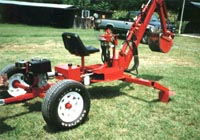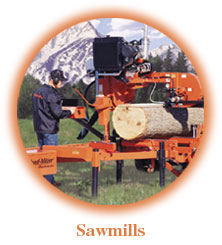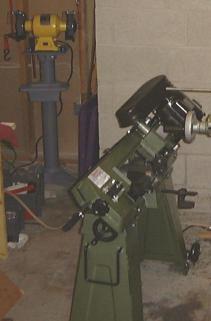
Some Thoughts on Scrounging.
By
Ronald E. Thompson
ęCopyright 2000, 2002
All Rights Reserved
In reading my favorite newsgroup, Rec.crafts.metalworking, I see people talking about the high cost of parts for their projects, and asking for advice on where to get metals, motors or hydraulic parts…and anything else that meets the needs of the projects at hand.
A lot of these posters seem to think that a part has to be new to be any good. This just isn’t so. Many good parts go unused simply because no one has seen the good in them.
For example, one gentleman (I’m giving him the benefit of the doubt because I don’t know him) was talking about building a project from the plans offered by Cadplans corp.

http://www.cadplans.com/diggers/index.htm
He was talking about the high cost of building using new parts. Admittedly, if all new materials are used, costs can be prohibitive. But used parts, especially from a cheap or free source, can make the difference between a project and just a dream.
The best way I know of to get free or cheap parts, is not to buy parts, but to obtain a machine that is no longer performing it’s designed function. This is commonly called JUNK. But is it really?
One source I like, and one you can use, is older riding lawnmowers. These machines are often overlooked (and under priced) because they will no longer perform their designed function, cutting grass. Usually the deck has rusted out and will no longer support the bearings for the blades. They are not much use for anything else. As a tractor they don’t have enough traction, and they are over powered because most of the horsepower was needed to power the blades. Most are still driveable, and are in pretty good shape. If you look at them as parts sources, they are gold mines. Engines, wheels/tires, axles, transmissions (some are even hydrostatic!), pulleys, bearings, and the list goes on.
One project that comes to mind for these parts would be a Band sawmill.
You could use a front wheel for the idler, incorporating an offset device to allow for blade tracking, and a back wheel for the drive. Make a suitable frame and run the blade over the tires.

Front Wheel................... Blade.......................... Rear Wheel
If you space the wheels just right, you could use stock blades from Woodmizer (relatively inexpensive and available by UPS).

Drive it from the motor via belts maybe using the transmission for speed reduction and for converting a vertical shaft motor to horizontal drive, if needed.
Instead of making the head move up and down to adjust the depth of cut, use wooden blocks to raise the log by that amount. This greatly simplifies construction.
Use the bearings from the blade shafts (of the mower) for blade guides (on the band saw) as they do on the famous $200 metal cutting band saws (similar bearings can be salvaged from car alternators).

These saws are imports and can be had from:
Watch for a sale, I have seen them for $159 with free shipping.
Fabricate a track from scrap pipe, channel or what have you. Put the track directly on the ground, using wooden shims to level. Use the other two wheels from the mower, without the tires to follow the guide rail (pipe) along one side. Use other scrounged wheels without tires or solid wheels (so they keep the same depth of cut) to support the other side. These run on a flat part on the track, so there is no fighting for alignment if your track isn’t perfect.
Need to cut 40’ beams? Making the track long enough is no sweat.
Need to make it portable? Add a couple of bumper jacks to one end and roll an axle/tire assembly under and bolt on. It’s easy to remove at the next job site. Put a tongue/hitch on one end, run wires through the pipe to the rear for tail lights.
Be sure to secure the motor/blade assembly before jacking and trailering!
Most parts can be from the riding mower. With some decent scrounging, and a welder, you could probably build this for a couple of hundred dollars (US, April, 2000).
How’s that for recycling?
OK, fine. But what about hydraulics, you say? Well…
I met a great guy through my web site. His name is Jim Dunmyer and he lives near Toledo, Ohio. His web site is worth a look @
http://www.oldengine.org/members/jdunmyer/
After some email I managed to visit, and Jim was kind enough to take the time to show me around. Unfortunately, Jim is not a reader of RCM, but he does attend N.A.M.E.S. and has some interesting toys. A sawmill, Bridgeport mill, huge LeBlond lathe, computer controlled wood stove, standby generator made from a VW diesel engine,…well look at his site.
To say the least, Jim is a scrounger extrordinaire!
One of the things he showed me was an old Tennant sweeper. It was propane powered for use inside large buildings. It was large enough that the operator rode on it as he drove (as opposed to smaller machines that you walk behind). It was sitting around unused, and was given to Jim for hauling it off! He brought it home, put fuel and a battery in it, and it started!
What is remarkable is the machine is hydraulic. It has a four cylinder motor, with a large hydrostatic pump on the flywheel end, and a power steering pump on the other, along with an alternator, water pump, radiator...etc. This machine is full of hydraulic motors, hoses, cylinders, control valves… you get the idea. With a little rearranging, and a few more parts, this thing would make a great Cad-digger! Plenty of power and electric start to boot.
Of course, don’t expect to have one of these given to you, but there are salvage yards all over that junk out equipment every day. Maybe they could be persuaded to let you pick over the pile. Or maybe you could put a small ad in the paper offering to buy old equipment for salvage prices. You may stumble across more than you ever dreamed!
So, what about metal?
Have you ever cut up an old water heater? These things are everywhere, and free!
How about uses for old clothes dryers? You may even be able to collect a fee for "disposing" of these.
They are sturdy enough for use as small work benches or tool stands, and have leveling feet. And after reclaiming the motor, belts, pulleys...etc for projects, the guts can be removed to make room for shelves. Turning the cabinet so the original front faces the wall, the back is open. This becomes the front for your shelves. Two of these windfalls spaced a few feet apart will support a benchtop made from two by fours or some thick plywood (or several layers of thinner plywood).
Electric motors such as the ones from the dryers are great for small shop tools. Some tools, however, require a little more power than one of these can produce. Why not gang them up? I had an old table saw that was underpowered with one of these 1/2 HP motors. I had a 3/4 HP laying around, but it wouldn't start by itself. The 1/2 had a shaft on each end, so I mounted the motors together and belted them on one end and then drove the saw from the other. It worked great. Just make sure your rotation direction and speed are compatable.
A homemade air compressor for the shop can be cobbled together from one of these motors and a used air conditioning compressor from a car. Add a new propane tank from Walmart for less than $20 or a portable air tank for a few dollars more, find a pressure switch, (new from a farm supply or used from an old well pump) and you are in business.
Not enough volume for air tools or spray painting? Well, these motors and compressors are cheap, so gang them up until you get the volume you need. (One motor to one compessor to make a unit) You still only need one tank and pressure switch, although you may want a larger tank. You can start with one unit and add more as you find them. If you get too many for your 115 V line, split them into two groups electricly, and plug into a 220V line.
If you get a used tank, be sure to hydrostaticly test it before you use it. This means fill the tank with water (including the fill pipe) and then applying pressure to the water. This way if your tank leaks all you get is a little water to indicate the leak. If you did this without the water, the tank could explode like a bomb. REALLY!
Don't forget to add a drain valve at the lowest part of the tank to drain the water that will accumulate.
Consider locating your compressor outside the shop, these things are noisy. At least run a pipe outside for the intake air. Use a filter, it makes the compressors last longer and helps quiet them down.